Please use a modern browser for the best user experience.

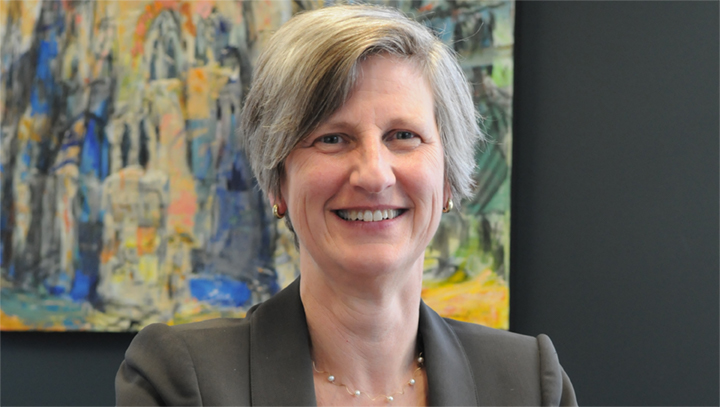
Since I arrived in this office in June 2018, I have had the privilege and honour of presiding over an extraordinary time of transition at the Library. And what a ride it has been. Early in 2019, Centre Block closed for renovations, which meant that the Library’s iconic Main Branch also had to close. It will be many years before these spaces reopen.
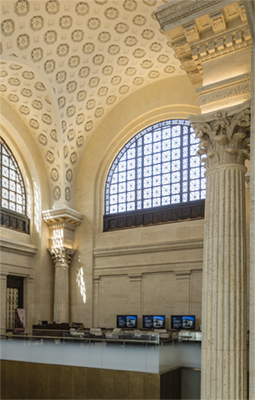 The Library’s focus throughout 2018–2019 was to manage a massive change while we continued serving clients to the highest possible standards. Did the closure create some upheaval? Certainly. But, through it all, our employees rose to the challenge, and I’m fiercely proud of what we’ve achieved. Even as we relocated 80% of our collections to a storage facility in Gatineau and opened or reopened Library branches across the Parliamentary Precinct, our clients had access to our products and services without interruption.
The Library’s focus throughout 2018–2019 was to manage a massive change while we continued serving clients to the highest possible standards. Did the closure create some upheaval? Certainly. But, through it all, our employees rose to the challenge, and I’m fiercely proud of what we’ve achieved. Even as we relocated 80% of our collections to a storage facility in Gatineau and opened or reopened Library branches across the Parliamentary Precinct, our clients had access to our products and services without interruption.
When conceptualizing our new Library locations, we had an ideal opportunity to rethink our service model. The result is five technologically sophisticated workspaces with services tailored to the needs of parliamentarians. The new branches are equipped with such amenities as meeting rooms, reading lounges, computers, tablets and other electronic devices, and media walls that stream parliamentary proceedings and news channels – and we provide face‑to‑face client services at reference desks in all of these locations. The spaces are modern, accessible and comfortable, and we are thrilled that parliamentarians and their staff are making use of them.
In our work behind the scenes, we continued to make improvements to ensure that the Library remains a trusted source of information. We offered enhanced training to employees in areas that matter to parliamentarians, including gender‑based analysis, international affairs and the delivery of complex information through high‑quality visual elements. As always, we supported parliamentary committees and associations, and produced research publications. We improved various Library tools that give clients access to our collections, and expanded our public outreach effort by redesigning how we welcome visitors to Parliament.
To keep our employees at the top of their game during a demanding time, the Library moved forward with our Healthy Workplace Strategy, which focuses on fostering an inclusive and respectful work environment, where employees are motivated and equipped to provide excellent service. All of our work in 2018–2019 was rooted in the Library’s strategic priorities of ensuring that we remain relevant to our clients, demonstrate agility in the face of rapid change, and nurture a healthy workplace.
As the new Parliamentary Librarian, I focused this year on getting to know our clients. I reached out to the Standing Joint Committee on the Library of Parliament, and made a point of meeting in person with newly appointed or elected parliamentarians.
 In some less formal activities, I sat down with the Right Honourable Richard Wagner, Chief Justice of Canada, for a conversation about his commitment to an accessible and transparent court system. The public affairs outlet CPAC broadcast an episode on the closing of the Main Library, and we hosted events to say goodbye to our Centre Block home and to welcome people to our Interim Main Library at 125 Sparks St. I also visited the University of Toronto’s Faculty of Information, where I spoke to students, faculty and alumni about the role of the Library in supporting Parliament and about the many exciting professional opportunities that exist here. I want graduates to know that the Library is modern and relevant, and a deeply rewarding place to work. We want Canada’s best and brightest to consider a career here.
In some less formal activities, I sat down with the Right Honourable Richard Wagner, Chief Justice of Canada, for a conversation about his commitment to an accessible and transparent court system. The public affairs outlet CPAC broadcast an episode on the closing of the Main Library, and we hosted events to say goodbye to our Centre Block home and to welcome people to our Interim Main Library at 125 Sparks St. I also visited the University of Toronto’s Faculty of Information, where I spoke to students, faculty and alumni about the role of the Library in supporting Parliament and about the many exciting professional opportunities that exist here. I want graduates to know that the Library is modern and relevant, and a deeply rewarding place to work. We want Canada’s best and brightest to consider a career here.
Throughout the year, we heard from parliamentarians about how important the Library is to the effective functioning of Parliament. We worked hard to communicate who we are, what we do and where they can find us, and to get better at learning what our clients need and expect.
The bulk of our achievements this year was the culmination of years of careful preparation by my predecessor, Sonia L’Heureux, and the Library’s staff. I want to express my profound gratitude for the work of such a capable and dedicated team of employees.
I would also like to express the pride, excitement and honour I feel to be serving the two houses of Parliament, as well as my appreciation for the engagement of both Speakers, whose support is essential to the success of the Library. I want to assure the Speakers that we at the Library will continue to innovate and to enhance our services, products and spaces to meet the changing needs and expectations of our clients.
Dr. Heather Lank
Parliamentary Librarian
10,104
visits by users to the Library’s locations
345,100
tour visitors
Over 4 million
users helped through the Canadian Parliamentary Historical Resources portal and Parlinfo
30,710
inquiries about Parliament from the public
55,000
e‑journals available to Library users
10,668
requests for information and reference services from parliamentarians and their staff
4,189
requests for research and analysis from parliamentary users
84
comparative analysis requests from European parliaments
The Library operates in an environment of rapid and continuous change. And our clients – parliamentarians, their staff and the public – expect us to move with the times.
The Library is committed to keeping our clients’ needs front and centre. We do this through our strategic commitments to stay relevant and agile, and to provide a healthy workplace where employees are empowered to do their very best work.
To stay relevant, we work to always provide clients with access to the right products and services, in the digital formats that they expect and need. To stay agile, we shift our focus, technologies and services to meet the needs of our clients and ensure that we have the ability to anticipate changes that are coming. To provide a healthy workplace where we can accomplish these tasks, we nurture employees who are capable of taking thoughtful risks and are open to learning from their successes and failures.
In 2018–2019, with the closure of Centre Block for renovations – and the simultaneous closing of the Library’s Main Branch – we managed change more profound than in any year in memory. Here are the highlights of what the Library accomplished to meet our strategic objectives through a year of major transition.
In December 2018, the Library’s Main Branch closed in conjunction with the start of a multi‑year renovation of Parliament’s Centre Block. To accommodate this change, we refurbished two branches: Confederation and our Interim Main Library (125 Sparks St.), and we opened two new branches: one in the Senate of Canada Building and the other in West Block. With our stunning branch at 180 Wellington St., which opened in January 2017, we now have five locations where we can serve clients in person.
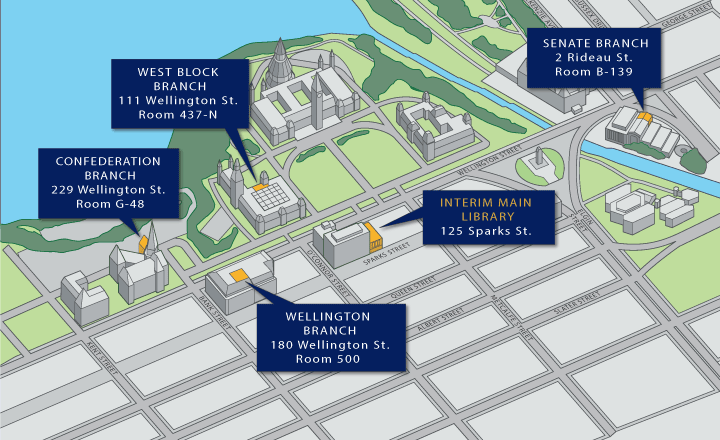
All five Library branches were designed as modern workspaces, offering a service model that better meets the needs of parliamentary clients. The locations feature various amenities, including:
A key goal throughout the transition was to ensure that users could access the Library’s products and services as easily as before.
![]() In one major move, the Library relocated much of its collection – more than 8,700 linear metres’ worth of materials – to our updated storage facility at 45 Boulevard Sacré‑Coeur in Gatineau, Quebec. The result is that, with the exception of the curated collections in our Library branches, the Gatineau facility is the location for our print and special collections, as well as for on‑demand digitization.
In one major move, the Library relocated much of its collection – more than 8,700 linear metres’ worth of materials – to our updated storage facility at 45 Boulevard Sacré‑Coeur in Gatineau, Quebec. The result is that, with the exception of the curated collections in our Library branches, the Gatineau facility is the location for our print and special collections, as well as for on‑demand digitization.
During the move, we made sure our clients were able to access our collections without interruption. And the facility is designed to ensure swift and efficient access to all our collections now and in the years ahead.
![]() In 2018–2019, the Library implemented a new evening duty model to ensure parliamentarians and their staff have access to in‑person reference services at the branch closest to each chamber whenever the chamber is sitting. Overall, foot traffic in Library branch spaces increased by about 20% this fiscal year.
In 2018–2019, the Library implemented a new evening duty model to ensure parliamentarians and their staff have access to in‑person reference services at the branch closest to each chamber whenever the chamber is sitting. Overall, foot traffic in Library branch spaces increased by about 20% this fiscal year.
 Guided tours: In February 2019, the Library began to offer two new guided tours for visitors: one of the Senate, now housed in the Senate of Canada Building, and the other of the House of Commons, now housed in West Block. The tours highlight the importance of Parliament, the work of the Senate and the House of Commons, and the history and architecture of the buildings.
Guided tours: In February 2019, the Library began to offer two new guided tours for visitors: one of the Senate, now housed in the Senate of Canada Building, and the other of the House of Commons, now housed in West Block. The tours highlight the importance of Parliament, the work of the Senate and the House of Commons, and the history and architecture of the buildings.
The move from Centre Block owed its success to years of planning with our partners from the Senate and House of Commons administrations and the Parliamentary Protective Service, as well as Public Services and Procurement Canada and its consultants. The Library’s team worked behind the scenes to coordinate the preparations of our visitor experiences materials – from online pre‑visit information to publications about Parliament and new training resources for staff – so that they would be ready when the new locations opened.
Online reservations: Visitors had the benefit of a new online reservation and ticketing system for guided tours of the new Senate and House of Commons locations, which we successfully launched, on time and on budget, in the fall of 2018.
 Virtual experience: The virtual experience project is a multi‑platform initiative that will allow a generation of Canadians to connect with Centre Block while it is closed for rehabilitation.
Virtual experience: The virtual experience project is a multi‑platform initiative that will allow a generation of Canadians to connect with Centre Block while it is closed for rehabilitation.
In partnership with the National Film Board, the Library completed a great deal of work on a 3‑D virtual‑reality production highlighting Centre Block and on an online interactive experience, both of which will be ready for the public early in 2020.
Independently, we are developing a travelling classroom program that we expect to launch in the winter of 2020, and an on‑site visitor destination in Ottawa whose opening is scheduled for early 2021.
New visitor centre: The Visitor Welcome Centre, which includes an expanded parliamentary boutique, serves as the new front door for visitors to the House of Commons in West Block. It features spaces dedicated to welcoming visitors, amenities to complement their experience, and a new video exhibit about Parliament.
In 2018, the Library finished the second phase of its web renewal project. We added lots of new content, including facts about the Library’s history, and we restructured our research publications pages to make the publications easier to retrieve and search. We also made it easier for users to access information on the Library’s website – especially when they are reading on their smart phones and tablets.
One highlight of the project is a new series called "Treasures of the Library." It explores the Library’s collection of rare books, art and artifacts; explains the work of Library employees; and highlights items from the history, heritage and early exploration of Canada.
A refreshed Learn about Parliament website allows us to share updated print publications and online resources about Parliament. A Visit Canada’s Parliament website details information about our guided tours of the new Senate and House of Commons locations.

The Library ran several social media campaigns in 2018–2019 to reach out to parliamentarians and the public about the many changes taking place.
The #OurParliament campaign highlighted Centre Block’s closure and the new visitor services offered at the Senate of Canada Building and West Block. It asked the public to share memories of Centre Block, and generated more than 900 posts using the #OurParliament hashtag. A focus on the changes related to the closure of Centre Block also helped us to increase the number of followers of the Library’s Instagram account.
The Library continued to focus on recruiting and developing top‑notch talent to meet the needs of parliamentarians. We enhanced our training for employees in several areas that parliamentarians told us were of particular importance, including gender‑based analysis plus (GBA+), international affairs and the creation of visual products to communicate complex information. Conferences and workshops led by Library experts and outside consultants supported our employees as they served the changing needs of parliamentarians.
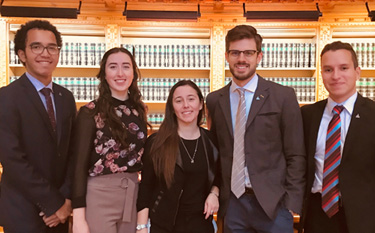 Relaunch of our internship program
Relaunch of our internship programSeptember 2018 saw the relaunch of the Library of Parliament Internship Program, which began in 2000 and was suspended in 2012 because of budgetary constraints.
The year‑long program, which is open to candidates from across Canada, provides paid internships to five university graduates. It allows interns to gain experience in the policy and legislative process, the development of Library products and services for parliamentarians, or in public education programming about Parliament.
Over the years, the Library has benefitted greatly from the internship program, as many interns have stayed with us long‑term as analysts, research assistants or librarians. As part of the 2018–2019 program, interns participated in a study trip to the Legislative Assembly of the Northwest Territories. They also participated in a mock Territorial Leadership Committee.
 The Library conducted its second annual healthy workplace survey in 2018, with employee participation in the survey rising by about 10% over the previous year. The survey polled employees on 13 psychosocial factors that contribute to a healthy workplace, such as workload management, engagement and psychological support.
The Library conducted its second annual healthy workplace survey in 2018, with employee participation in the survey rising by about 10% over the previous year. The survey polled employees on 13 psychosocial factors that contribute to a healthy workplace, such as workload management, engagement and psychological support.
The responses to the 2018 survey showed improvements in all 13 factors compared with 2017. While it is premature to conclude that there is a trend, we were pleased to see the improved results and believe that the implementation of our five‑year plan for workplace health, called Healthy Workplace Strategy, played a role.
Initiatives in 2018–2019 included the following:
The Library also developed a policy to support the promotion of diversity and inclusion in the workplace. The policy was a result of extensive research into community best practices and policies, consultations with our unions on the subject, and analysis of Bill C‑81, An Act to ensure a barrier‑free Canada.
We completed another important piece of work with the development and dissemination of a new guide on how to use inclusive language in English and French. The guide helps Library authors as they develop documents.
To meet the needs of our clients, the Library provides a wide variety of services – from customized research for legislators to the provision of classroom materials for teachers. In all our service offerings, we strive for continuous improvement.
In 2018–2019, the Library saw high demand for its services.
|
User Group |
Information and Reference1 |
Research and Analysis2 |
|---|---|---|
|
Parliamentarians and their staff (including constituency staff) |
10,412 |
1,176 |
|
Senators |
2,057 |
280 |
|
Members of the House of Commons |
8,355 |
896 |
|
Parliamentary committees, associations and delegations |
256 |
2,999 |
|
Senate committees |
24 |
693 |
|
House of Commons committees |
34 |
1,322 |
|
Associations and delegations |
198 |
984 |
|
Employees of the Senate, the House of Commons and the Library of Parliament |
4,890 |
– |
|
General public |
30,710 |
– |
|
Other authorized users3 |
3,101 |
14 |
|
Total |
49,369 |
4,189 |
The Library’s research librarians and information and research technicians help parliamentarians and their staff by answering their questions on many topics. They curate news and other information and perform custom information searches and fact‑checking using our collection.
The information service team also answers questions from the public. Topics can range from ways to visit Parliament to the role of Parliament or the history of the institution. We get thousands of requests every year for public education materials and Sessional Papers.
The Library’s teams of analysts, research assistants, interns and others answer parliamentarians’ requests through emails, in‑person briefings or custom research papers.
Research staff responded to 1,176 requests from parliamentarians and their staff.
The Library’s subject‑matter experts answered 2,999 requests for research and analysis services from Senate and House of Commons committees and parliamentary associations, and delegations.
Library analysts assigned to parliamentary committees were tasked with giving ongoing support by:
The Library assigned analysts to 50 committees in the Senate and the House of Commons, including three special committees and subcommittees.
Research staff prepared
research documents for parliamentary committees.
Analysts assigned to the Standing Joint Committee for the Scrutiny of Regulations completed
work items of all sizes – from full reports to emails and brief notes.
The Library also assigned analysts to all 13 parliamentary associations. They were tasked with giving ongoing support by:

In 2018–2019, research staff completed more than 980 requests from associations and delegations. This number has more than doubled since 2016–2017.
This growth has occurred because parliamentarians have been attending more international meetings, missions and conferences – and because the Library has invested in more resources than in the past to support Parliament’s enhanced international engagement.
We have also bolstered our international media monitoring due to high interest in international affairs. As one example, we have increased the number of editions of Quorum – World News (a collection of top news stories) from one to three per week.
The Library produced a wide range of online research publications in 2018–2019. These documents analyzed issues, legislation and important public policy topics for parliamentarians, committees and associations.
Legislative Summaries (not counting pre‑release summaries)
Plain-language explanations of the purpose and history of government bills and private members’ bills
Background Papers and In Briefs
In‑depth studies on policy issues, as well as short reports on current topics, with links to more substantive sources on the same topic
HillNotes
Concise overviews of current and emerging issues of immediate interest to parliamentarians
Trade and Investment profiles
Information on Canada’s trade relationships with other countries
 The Library’s Twitter accounts @LoPResearch and @BdPRecherche help parliamentarians and their staff stay connected with the Library’s research. In 2018–2019, we gained a total of 386 new followers on the two accounts.
The Library’s Twitter accounts @LoPResearch and @BdPRecherche help parliamentarians and their staff stay connected with the Library’s research. In 2018–2019, we gained a total of 386 new followers on the two accounts.
![]() English users were most interested in tweets that sent them to our Legislative Summary of Bill C‑45 (Cannabis Act) and to the HillNote Changing the Machinery of Government: Indigenous Affairs Portfolio.
English users were most interested in tweets that sent them to our Legislative Summary of Bill C‑45 (Cannabis Act) and to the HillNote Changing the Machinery of Government: Indigenous Affairs Portfolio.
French users were most interested in tweets that sent them to the In Brief Est‑ce que le suivi des résultats fait une différence? and to the HillNote Être ou ne pas être un haut fonctionnaire du Parlement, telle est la question.
Many people process, understand and remember high‑quality visuals more easily than text. The Library uses content‑rich maps, charts, graphs and infographics to synthesize and communicate complex information in research publications and committee reports prepared by its analysts. In 2018–2019, we increased our capacity to provide these products to parliamentarians.
Geographic information system (GIS) mapping is one type of visual the Library uses to explain topics and trends that parliamentarians care about. For example, we made GIS maps that show refugee flows, wildfire patterns, migratory routes for the monarch butterfly and many other patterns. In 2018–2019, the Library produced 112 static and web‑based maps – and many other visuals – to support Parliament’s work. We made visuals for:
The Library helps parliamentarians and their staff stay up to date with the news and current affairs that affect their daily work. Our experts curate the information and resources most relevant to parliamentarians.
In 2018–2019, we offered:
editions of Quorum
(1,061 subscribers)
Quorum is a daily collection of top Canadian news stories
editions of Quorum – World News
(717 subscribers)
Quorum – World News expanded its offerings from one to three issues per week, in support of Parliament’s ongoing interest in international affairs
personalized NewsDesk notifications
(750 subscribers; close to 1.2 million page views)
NewsDesk is a media monitoring tool offering full‑text access to Canadian and international news sources
Radar editions
(839 subscribers; 6,484 articles requested)
RADAR is a compendium of reports, articles and other documents on issues of interest to parliamentarians
"Databases A–Z" is a popular tool with clients who are looking to access the Library’s electronic subscriptions. In 2018–2019, clients used the tool more than 10,000 times to find the most relevant resources for their work – a 17% increase over the previous year.
The Library also updated how "Databases A–Z" searches for information. Now, the tool is more effective and easier for clients to use.
Subject guides give parliamentarians and their staff access to reliable and authoritative resources on specific topics. The guides point our clients toward current publications and databases in the Library’s collections that are relevant to their needs.
Our subject guides were consulted 5,491 times in 2018–2019, an 11% increase in sessions over the previous year.

Library users are relying more and more on the online news services, blogs and electronic newspapers and magazines that we provide.
In 2018–2019, using the Library’s most popular newspaper and magazine app, they read more than 237,000 articles – 39% more than the previous year. The app gives access to more than 7,200 titles.
Our media monitoring tool, and other news websites and blogs to which the Library provides access, generated nearly 1.5 million page views:
The Library devotes a considerable portion of its resources to keeping our collections relevant and up to date for Parliament. In 2018–2019, we continued to develop our collections on several fronts.
We worked with subject‑matter experts to pinpoint the areas of our collections that need to grow, and we began to use a new tool that will boost our ability to consolidate our usage metrics. This information helps the Library to make evidence‑based decisions about how to add to and streamline our collections in future.
The Library moved its collections to several new locations before Centre Block closed, with our team continuing its careful work of keeping detailed inventories and recording our progress. In this way, we made sure we knew the precise locations of all our collections throughout the transition, with no interruptions in access for our clients.
We migrated the Library of Parliament Catalogue to a new client interface, which has made the Library more agile and enabled us to improve our clients’ access to our collections.
We have also made our catalogue available to the public, which puts our practice in line with that of other legislative libraries across Canada and around the world.

In 2017, the Library secured a larger and more stable budget for developing and digitizing its collection. In 2018–2019, we conducted several product trials and assessments with vendors to choose the products that can best serve our clients.
As a result, we expanded access to core legal resources, and we are offering new subscriptions that cover a wide array of subjects: science, social sciences and humanities, economics and finance, business and industry, current affairs, and statistical and specialized data sets.
The Library also digitized and catalogued 678 Sessional Papers.
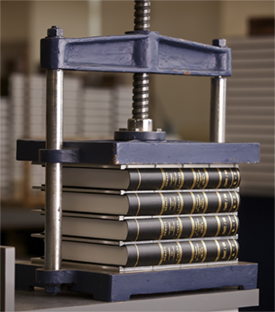 The Preservation Laboratory and its bindery service took on multiple special projects in 2018–2019, including the following:
The Preservation Laboratory and its bindery service took on multiple special projects in 2018–2019, including the following:
As the Library’s Main Branch prepared to close for the decade‑long rehabilitation of Centre Block, we opened four new and refurbished locations across the Parliamentary Precinct:
With our branch at 180 Wellington St., which opened in July 2017, we now serve our clients through five Library branches.

The Library ran a series of pop‑up booths in 2018–2019 in the East Block, Centre Block and Wellington buildings. This led to dozens of interactions with parliamentarians, their staff and others to share information about our new locations and our services, and to learn about their needs. We produced a postcard that shows the five branch locations, and we ran orientation and information sessions to raise awareness about the Library’s new spaces.
The Library provides high‑quality learning opportunities and seminars for parliamentarians and their staff on public policy, legislation and other topics. We also train in person and online to help parliamentarians to use our services and to teach them about the many resources we provide.
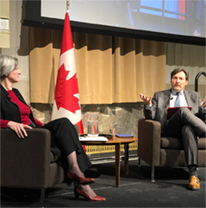 In 2018–2019, we continued our focus on recruiting high‑profile guests for our seminars and strengthened our relationships with forward‑thinking professional‑development providers. The average attendance at our seminars continued to be strong – double what it was 10 years ago.
In 2018–2019, we continued our focus on recruiting high‑profile guests for our seminars and strengthened our relationships with forward‑thinking professional‑development providers. The average attendance at our seminars continued to be strong – double what it was 10 years ago.
This year, the Parliamentary Librarian sat down with the Right Honourable Richard Wagner, Chief Justice of Canada, for a conversation about his commitment to a more accessible and transparent court and judicial system. They also talked about the role he sees for Canada’s institutions at home and abroad.
The Library delivered the first full year of "Information Sessions in Our Library Branches" in 2018–2019.
The year’s 56 sessions were designed to teach our clients the best ways to use Library resources and services. The sessions also let us hear from Library users about the information they need, and how well they understand and use the Library’s resources.
Ninety‑seven percent of attendees said they would use the resources we talked about, and we got a wealth of feedback that will help us design future training. This program expanded the reach of our training programs.

The Library conducted more than 150 outreach sessions to help orient and train parliamentarians and their staff about the Library’s resources and services.
Most sessions involved in‑person visits and training, because many of our clients prefer direct contact with Library staff. The most popular sessions focused on Library products and services in specific subject areas.
We also expanded our offerings in 2018–2019, developing a new session on legal resources and extending our reach across the Parliamentary Precinct and into virtual training sessions with clients in constituency offices.
The Library’s information service answers general questions about the Parliament of Canada. In 2018–2019, our staff responded to more than 30,000 queries from the public about Parliament’s role, history and work. We also gave people access to such documents as Sessional Papers, and we helped them to find the parliamentary offices and resources they were looking for.
One way to be agile and responsive to the needs of clients is to make it easy for them to find resources and documents. Whenever possible, we provide digital versions, because they are simpler for people to access than materials in other formats.

The Library continued to enlarge its collection of historical resources, which will help to ensure the long‑term preservation of this important information. We did this through two databases: Canadian Parliamentary Historical Resources and Parlinfo.
The Library works closely with the Canadian Research Knowledge Network and Canadiana.org to give our clients easy access to Canadian Parliamentary Historical Resources. This online portal has full‑text, searchable parliamentary publications since 1867 for the Senate and the House of Commons – all in English and French. In 2018–2019, we continued a major effort to produce digital versions of parliamentary publications. The project digitized 2,700 items or more than 2.2 million pages – mostly committee documents and historical bills – which are now available through the portal.
In 2017, we launched a renewed Parlinfo; the database was completely redesigned to make it more informative and user‑friendly. Parlinfo is our unique collection of data about the people and events that have made up Canada’s Parliament from 1867 to today. In 2019, we completed a Parlinfo renewal when we added data and functionality that give our clients access to such information as:

One way to make sure the Library stays relevant to Parliament is to get regular feedback from clients. In 2018–2019, we aimed at that goal when we:
The Library welcomes visitors to Parliament and educates the public in many ways. Our offerings include guided tours, educational tools, interactive websites and publications for Canadians of all ages.
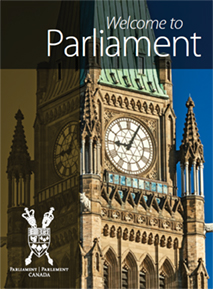 In 2018–2019, the Library welcomed visitors to Parliament with guided tours of Centre Block and East Block. We also offered informal tours of the Peace Tower observation deck and Memorial Chamber. New guided tours of the Senate of Canada Building and West Block began on February 1, 2019.
In 2018–2019, the Library welcomed visitors to Parliament with guided tours of Centre Block and East Block. We also offered informal tours of the Peace Tower observation deck and Memorial Chamber. New guided tours of the Senate of Canada Building and West Block began on February 1, 2019.
We made many educational products available to teachers, youth and the general public. And we used social media and the web to help Canadians understand how Parliament works.
We conducted a successful national promotional campaign, which helped make the public more aware of the resources, products and services available from Parliament. The campaign also helped us recruit new parliamentary guides and teachers to participate in our annual Teachers Institute on Canadian Parliamentary Democracy.
The results from our national campaign include:
new followers on the Parliament of Canada’s @PARLyouth and @PARLjeunes Facebook pages, for a total of 46,000
views on the PARLyouth and PARLjeunes YouTube channels
views for Our Country, Our Parliament
views for Discover How Canadians Govern Themselves
![]() Centre Block tours: The Library welcomed more than 308,500 visitors to Centre Block on guided tours between April 2018 and January 2019. Visitors included more than 56,500 students and teachers who discovered the people, history, functions, art and architecture of Parliament.
Centre Block tours: The Library welcomed more than 308,500 visitors to Centre Block on guided tours between April 2018 and January 2019. Visitors included more than 56,500 students and teachers who discovered the people, history, functions, art and architecture of Parliament.
East Block tours: From July to September 2018, nearly 17,300 visitors explored four heritage rooms restored to their appearance in 1872.
![]() Visits to the Peace Tower observation deck and Memorial Chamber: The Library welcomed the public in 2018–2019 to visit the Peace Tower observation deck and the Memorial Chamber. Our guides provided informal interpretation about Canada’s military contributions and the Books of Remembrance, which honour those who died in service to Canada. More than 154,500 people visited.
Visits to the Peace Tower observation deck and Memorial Chamber: The Library welcomed the public in 2018–2019 to visit the Peace Tower observation deck and the Memorial Chamber. Our guides provided informal interpretation about Canada’s military contributions and the Books of Remembrance, which honour those who died in service to Canada. More than 154,500 people visited.
![]() Library exhibit: Before Centre Block closed, the Library showcased an interactive exhibit called "Landmark Moments: The Stories of Centre Block." The exhibit celebrated the history of this historic building by highlighting important moments and events that took place within its walls and on its steps.
Library exhibit: Before Centre Block closed, the Library showcased an interactive exhibit called "Landmark Moments: The Stories of Centre Block." The exhibit celebrated the history of this historic building by highlighting important moments and events that took place within its walls and on its steps.
Senate of Canada Building and West Block tours: In February 2019, following the closure of Centre Block to the public, the Library began offering tours of the Senate of Canada Building and West Block. In February and March 2019, we offered tours to more than 7,500 visitors in the Senate of Canada Building and more than 11,800 visitors in West Block.
![]() Parliamentary Boutique: The boutique in Centre Block was closed, and a new boutique with expanded offerings was opened in the Visitor Welcome Centre. We introduced more than 100 new products in 2018–2019 and improved the process for ordering items. This included adding next‑day delivery, and streamlining our credit‑card payment system.
Parliamentary Boutique: The boutique in Centre Block was closed, and a new boutique with expanded offerings was opened in the Visitor Welcome Centre. We introduced more than 100 new products in 2018–2019 and improved the process for ordering items. This included adding next‑day delivery, and streamlining our credit‑card payment system.
 Nearly 300 young Canadians applied for the Library’s Parliamentary Guide summer work program in 2018. The program offers bilingual students a chance to work at the centre of Canadian democracy. It also helps them to work on their public‑speaking and second‑language skills. The Library hired 40 university students from seven provinces to give tours of Centre Block.
Nearly 300 young Canadians applied for the Library’s Parliamentary Guide summer work program in 2018. The program offers bilingual students a chance to work at the centre of Canadian democracy. It also helps them to work on their public‑speaking and second‑language skills. The Library hired 40 university students from seven provinces to give tours of Centre Block.
In anticipation of the start of tours at the Senate of Canada Building and West Block, the Parliamentary Tour Program expanded its winter 2018 recruitment campaign with a new promotional strategy that included more targeted recruitment of university students in the National Capital Region. As a result, we recruited 32 more guides for winter, for a total of 67.
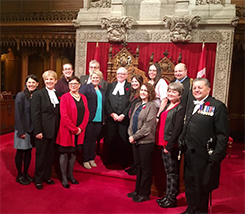 The Teachers Institute on Canadian Parliamentary Democracy gives 85 teachers from across Canada an inside view of how Parliament works. It is an intense professional development opportunity that results in teachers bringing new knowledge back to their classrooms.
The Teachers Institute on Canadian Parliamentary Democracy gives 85 teachers from across Canada an inside view of how Parliament works. It is an intense professional development opportunity that results in teachers bringing new knowledge back to their classrooms.
The 22nd edition of the program began with a keynote address from the Honourable Ethel Blondin‑Andrew, who was the first Indigenous woman elected to Parliament. She was also a Secretary of State and a Minister of State in the governments of former prime ministers Jean Chrétien and Paul Martin.
This was the last time before it closed that Centre Block would be the location for the Institute, so Parliament pulled out all the stops to give teachers a special experience.
Deploying the team in our Ambassador Program is one of the most significant ways in which the Library reaches out to parliamentarians. The program is especially important when the Library welcomes new senators and members of the House of Commons.
Ambassadors meet with parliamentarians and their staff in person, helping them to understand the Library’s products and services, and building strong relationships. In 2018–2019, Library ambassadors made 30 visits to parliamentarians and their staff and presented to many groups, including Hill partners and staff in research offices.

The Parliamentary Poet Laureate, Georgette LeBlanc, was highly productive in 2018–2019. She wrote works commissioned by senators and members of the House of Commons, and read in several poetry festivals. She continued the Poem of the Month program and also released a short film, Planet Clare, which presents the Acadian language of the region of Baie Sainte‑Marie, Nova Scotia, and its people.
Georgette LeBlanc is working on a vinyl album – an audio edition of one of her books, Le Grand Feu – that includes original songs. She will release the album in 2019–2020.
Canada’s eighth Poet Laureate, Georgette LeBlanc is the second woman to hold the position. The Parliament of Canada created the Poet Laureate position in 2001.
![]() Our Twitter accounts, @LoPInformation and @BDPInformation, grew by 257 followers in 2018–2019, an average of 21 new followers per month. We posted 552 tweets, and the accounts saw 673 retweets and 377 mentions. Our tweets were favorited 661 times.
Our Twitter accounts, @LoPInformation and @BDPInformation, grew by 257 followers in 2018–2019, an average of 21 new followers per month. We posted 552 tweets, and the accounts saw 673 retweets and 377 mentions. Our tweets were favorited 661 times.
![]() Our bilingual Instagram account, which we launched in January 2018, now has more than 1,100 followers. Content focused on the Library’s role in the many projects taking place throughout the Parliamentary Precinct following the closure of Centre Block.
Our bilingual Instagram account, which we launched in January 2018, now has more than 1,100 followers. Content focused on the Library’s role in the many projects taking place throughout the Parliamentary Precinct following the closure of Centre Block.
![]() The Library’s LinkedIn account has 534 followers, and we use it mainly to find new talent. We also use it to promote the research publications that are most relevant to the people in our professional networks.
The Library’s LinkedIn account has 534 followers, and we use it mainly to find new talent. We also use it to promote the research publications that are most relevant to the people in our professional networks.
To give the best possible service to parliamentarians and the public, Library employees need strong support from the organization. We provide this through a variety of services from our finance, human resources, information technology, and publication professionals. We also have the benefit of support from the Library’s general counsel.
Following a successful renewal project in 2017, our corporate services team continued to work closely with other service areas at the Library, deepening the team’s understanding of the roles, challenges and needs of those areas. The result was better engagement with internal clients, and stronger working relationships and alignments with the Library’s parliamentary partners and others.
|
VISION To be Parliament’s preferred and trusted source of information and knowledge. |
MISSION The Library of Parliament contributes to Canadian parliamentary democracy by creating, managing and delivering authoritative, reliable and relevant information and knowledge for Parliament. |
STRATEGIC OUTCOME An informed and accessible Parliament. |
|
VISION To be Parliament’s preferred and trusted source of information and knowledge. |
|
MISSION The Library of Parliament contributes to Canadian parliamentary democracy by creating, managing and delivering authoritative, reliable and relevant information and knowledge for Parliament. |
|
STRATEGIC OUTCOME An informed |
|
SPEAKERS OF THE SENATE AND THE HOUSE OF COMMONS |
LIBRARY OF PARLIAMENT |
PARLIAMENTARY LIBRARIAN |
|
STANDING JOINT COMMITTEE ON THE LIBRARY OF PARLIAMENT |
SERVICE AREAS Parliamentary Information and Research Service Information and Document Resource Service Business Support Services |
|
LIBRARY OF |
|
|
SPEAKERS OF THE SENATE AND THE HOUSE OF COMMONS |
PARLIAMENTARY LIBRARIAN |
|
STANDING JOINT COMMITTEE ON THE LIBRARY OF PARLIAMENT |
SERVICE AREAS Parliamentary Information and Research Service Information and Document Resource Service Business Support Services |
|
SPEAKERS OF THE SENATE AND THE HOUSE OF COMMONS |
Vested with the direction and control of the Library of Parliament in accordance with the Parliament of Canada Act |
|---|---|
|
STANDING JOINT COMMITTEE ON THE LIBRARY OF PARLIAMENT |
Composed of senators and of members of the House of Commons responsible for assisting the Speakers on the operations of the Library |
|
PARLIAMENTARY LIBRARIAN |
Exercises control and management of the Library and has the status of a Deputy Head, reporting to the two Speakers |
|
PARLIAMENTARY INFORMATION AND RESEARCH SERVICE |
Provides parliamentarians with news, reference, research, and analysis services and oversees the Library’s public education programs and seminars for parliamentarians and their staff |
|
INFORMATION AND DOCUMENT RESOURCE SERVICE |
Builds, manages, preserves and optimizes access to the Library’s resources and collections; compiles and disseminates historical information about Parliament and parliamentarians; and acts as the steward for the Parliamentary Poet Laureate |
|
BUSINESS SUPPORT SERVICES |
Provides business support and services to the Library of Parliament |
The Library of Parliament has five key responsibilities:
|
Senators |
105 |
|---|---|
|
Members of the House of Commons |
338 |
|
Total |
443 |
|
Senate committees |
18 |
|---|---|
|
House of Commons committees |
29 |
|
Joint committees2 |
3 |
|
Parliamentary associations |
13 |

Left to right: Sonia Bebbington, Director General, Information and Document Resource Service; JoAnne St‑Gelais, Director General, Business Support Services; Dr. Heather Lank, Parliamentary Librarian; and Catherine MacLeod, Assistant Parliamentary Librarian
|
Type of Service |
Main Estimates |
Supplementary Estimates and Adjustments |
Total Authorities |
Actual Spending |
|
|---|---|---|---|---|---|
|
Parliamentary Information and Research Service |
Research and Analysis |
11,930,450 |
212,461 |
12,142,911 |
11,573,002 |
|
Reference Services |
5,347,044 |
– |
5,347,044 |
5,388,736 |
|
|
Public |
5,323,866 |
– |
5,323,866 |
5,100,919 |
|
|
Information and Document Resource Service |
8,403,185 |
– |
8,403,185 |
7,920,673 |
|
|
Business Support Services |
11,199,171 |
107,902 |
11,307,073 |
12,022,038 |
|
|
Office of the Parliamentary Librarian2 |
885,883 |
– |
885,883 |
876,122 |
|
|
Employee Benefit Plan |
4,996,406 |
(348,505) |
4,647,901 |
4,647,901 |
|
|
Total |
48,086,005 |
(28,142) |
48,057,863 |
47,529,391 |
|
View the audited financial statements ![]() (370 kB, 24 pages)
(370 kB, 24 pages)
2016–2017
2016– 2017
2017–2018
2017– 2018
2018–2019
2018– 2019
 Main estimates
Main estimates
 Total authorities1
Total authorities1
 Actual spending
Actual spending
|
Fiscal Year |
Main estimates |
Total authorities1 |
Actual spending |
|---|---|---|---|
|
2016–2017 |
43.07 |
42.47 |
42.44 |
|
2017–2018 |
47.76 |
48.27 |
45.63 |
|
2018–2019 |
48.09 |
48.06 |
47.53 |